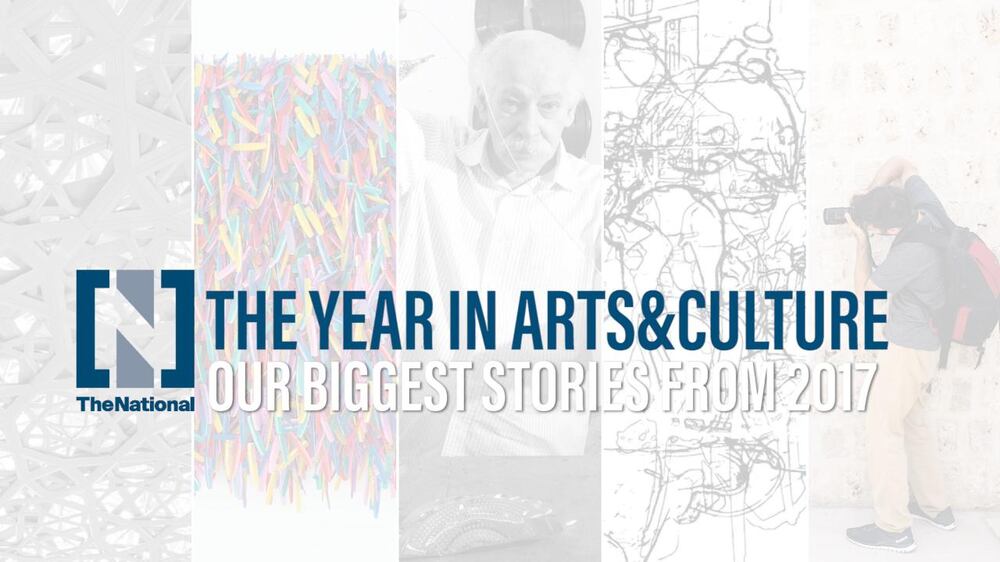But We Cannot See Them: Tracing a UAE Art Community, 1998-2008, NYUAD Art Gallery
After a series of exhibitions that have been thoughtful, intellectually engaging and relevant, Maya Allison and her team at the New York University Abu Dhabi Art Gallery finally delivered a show that was all of those things as well as being art-historically important.
But We Cannot See Them not only evoked the story of the community that gathered around the late Hassan Sharif but also provided a first draft for the as-yet unwritten story of contemporary art in the Emirates, supported by important interviews and much-needed primary research.
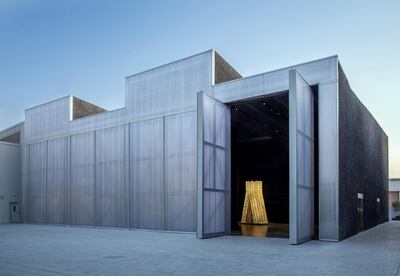
Concrete at Alserkal Avenue, Dubai
When Concrete opened in March, the building’s potential was unclear. Would its reputation rest more on its rarity value – it remains the only structure to have been built by Rem Koolhaas’s Office for Metropolitan Architecture in the UAE – or would it bolster Alserkal Avenue’s burgeoning reputation?
Early signs were unpromising. Traditional, wall-mounted exhibitions sit uneasily in the space but with While We Wait, the V&A-commissioned architectural installation by Palestine's AAU Anastas, the building suddenly came into its own. A dramatic programme is required if the folk at Alserkal Avenue are to get the best out of Concrete, but that's surely a challenge they are happy to have.
Art Jameel, Dubai
Art Jameel’s activities succeeded in garnering headlines throughout 2017. Operating under Antonia Carver’s leadership out of the humble Project Space Art Jameel at Alserkal Avenue in Dubai, the organisation not only hosted important exhibitions such as Egyptian artist Maha Maamoun’s first solo show in the Gulf, but also announced the 2018 opening of the new 10,000-square metre, three-storey Jameel Arts Centre on Dubai Creek and a multi-year international art commissions programme. Watch this forthcoming space.
Sharjah Biennial 13: Tamawuj
With the 13th Sharjah Biennial, which took place in Dakar, Istanbul, Ramallah and Beirut as well as Sharjah, Lebanese curator Christine Tohmé succeeded in pushing the event’s format and the team at Sharjah Art Foundation to their limits. The events may have been disparate, but the effect was definitely more than the sum of its parts, regionalising the Biennial’s traditional acts of patronage and cementing its reputation as a heavyweight international art event whose reach extends far beyond the UAE and the concerns of the market. Inspiring.
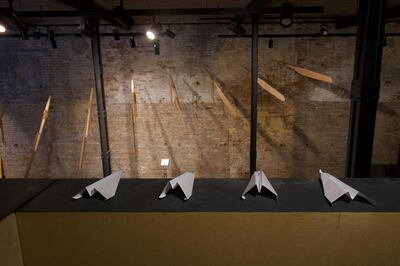
Rock, Paper, Scissors: Positions in Play, National Pavilion UAE at Venice Biennale
Reactions were mixed to the Hammad Nasar-curated UAE National Pavilion at the 57th Venice Biennale, which featured work by five artists who each call the UAE home: Nujoom Alghanem, Sara Al Haddad, Vikram Divecha, Lantian Xie and Dr Mohamed Yousif.
Nasar’s vision is best understood when the artists who were featured in the exhibition are considered alongside the writers, thinkers and artists he included in the accompanying publication, such as Reem Fadda and Maisa Al Qassemi, Uzma Rizvi and Murtaza Vali, Deepak Unnikrishnan, Ramin Haerizadeh, Rokni Haerizadeh and Hesam Rahmanian.
For a curator from outside the UAE to have reflected on the country's current pool of creatives so accurately and so inclusively is impressive, as he essentially did for the current moment what Maya Allison's Because We Cannot See Them did for a previous generation. It will probably take a generation for Nasar's curatorial perspicuity to be fully appreciated, but when that happens he is sure to be applauded.
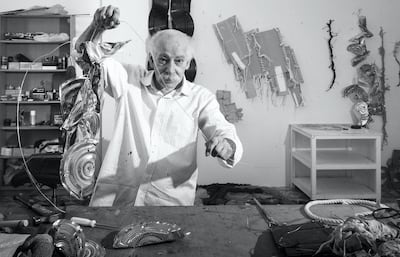
Hassan Sharif: I Am The Single Work Artist, Sharjah Art Foundation
Overshadowed somewhat by the brouhaha that surrounded the opening of Abu Dhabi Art and Louvre Abu Dhabi, this landmark exhibition dedicated to the UAE’s most significant home-grown artist establishes the breadth and abundance of Hassan Sharif’s intellect and talent.
Sharif's work can sometimes seem derivative of western precedents when seen in isolation, but the 300-work, Sheikha Hoor Al Qasimi-curated I Am The Single Work Artist not only investigates Sharif's debt to his UK art education but succeeds in communicating just what it took to be the UAE's most pioneering artist for more than three decades.
Saudi Arabia
Whether it was the opening of the first contemporary art exhibition to be curated by Saudi women, October's We Are Not Alone at Athr Gallery in Jeddah, international shows such as July's Epicenter X: Saudi Contemporary Art in Dearborn, MI, or Bader bin Abdullah bin Mohammed bin Farhan al-Saud's role in the purchase of Leonardo da Vinci's Salvator Mundi, culture kept Saudi Arabia in the headlines throughout 2017.
Alongside the decision to lift the Kingdom’s 35-year-old ban on cinemas, Saudi Arabia’s Crown Prince, Mohammed bin Salman bin Abdulaziz Al Saud also recently launched an artistic arm of his philanthrophic Misk Foundation with the intention of becoming the Kingdom’s “leading platform for grassroots cultural production, diplomacy and exchange” under the direction of the eminent Saudi artist Ahmed Mater.
As well as launching an architectural competition for the foundation's Riyadh headquarters, Mater is looking for a venue for the Kingdom's pavilion for the Venice Biennale, which will make its debut next year. Saudi's exciting cultural renaissance is a story that will run and run.
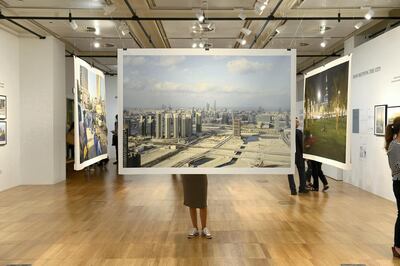
Learning from Gulf Cities at NYUAD
Only posterity will show whether such a modest show really warrants its own place in an annual review, but if Harvey Molotch, Davide Ponzini and Michele Nastasi's forthcoming publication is anything like their exhibition at NYUAD, then Learning from Gulf Cities is likely to be considered as a turning point in studies of Gulf urbanism.
Learned, research-based and committed to avoiding the usual clichés that define western depictions of cities such as Dubai, their study attempts to understand the region on its own terms. It’s a shame that such research is still being produced by outsiders, but with Dr Khaled Alawadi’s curation of next year’s UAE National Pavilion at the Venice Architecture Biennale, UAE-based research is sure to come to the fore.
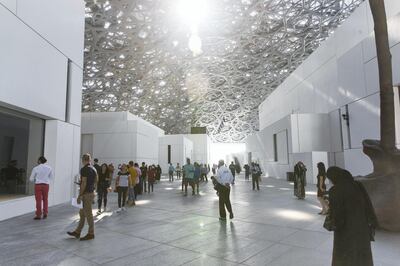
Louvre Abu Dhabi
2017 was undoubtedly a year of museum “firsts”. There was the first contemporary art museum in Africa, the 100,000-square-foot Zeitz MOCAA in Cape Town; Museum Macan, Indonesia’s new modern art museum; and not one but two museums dedicated to the French fashion icon Yves Saint Laurent, one in Paris and the other in Marrakech.
All of these, however, were overshadowed by the opening of the museum on our doorstep, Louvre Abu Dhabi. After writing so many thousands of words about the museum over the past five years, what more is there to say? Only that it has exceeded all expectations and that is without the inclusion of the artwork that continues to dominate the end-of-year headlines…
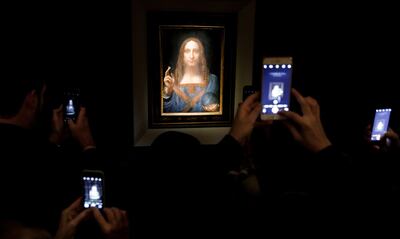
Leonardo Da Vinci’s Salvator Mundi
There is a certain inevitability about the fact that the world's most expensive and most controversial painting should end up at Louvre Abu Dhabi.
Nothing about how it will have got here, when it will arrive and how it will be displayed by Abu Dhabi's Department of Culture and Tourism detracts from the significance of having it here in the Arab world, displayed alongside Leonardo's La Belle Ferronnière, currently on loan from The Louvre in Paris.
Acquiring one of the few authenticated da Vinci paintings in existence within a month of its opening is a huge coup for the Louvre Abu Dhabi and all eyes will surely be focused on the acquisition the Saadiyat Island museum makes next.
___________________________
Read more:
My Place is the Placeless: Shahpour Pouyan at Lawrie Shabibi, Dubai
Louvre Abu Dhabi: UAE has acquired Da Vinci's Salvator Mundi
Local industry reacts to Saudi cinema opening announcement
___________________________
